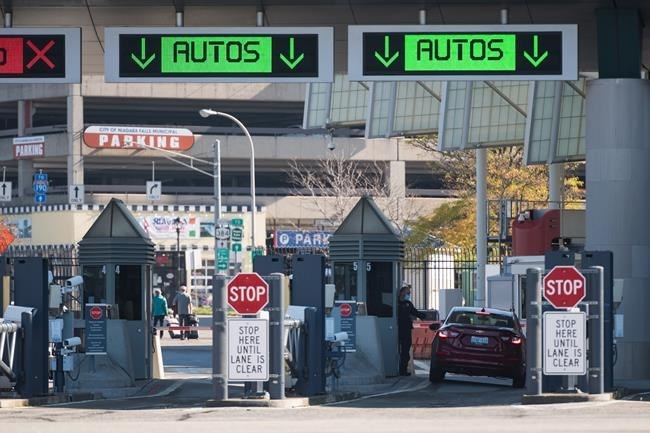WASHINGTON — Canada is embarking on an effort to test the boundaries of its shared border with the United States, launching a pilot project that would allow northbound land travellers to clear customs while still on U.S. soil.
The federal government is soliciting public comment on the planned project, which would establish a preclearance zone inside a Customs and Border Protection facility in Cannon Corners, N.Y., south of Montreal.
"Here's the announcement we've been waiting for," the binational Future Borders Coalition lobby group enthused last week in an email to its membership.
The notice says the Canada Border Services Agency hopes to launch the two-year project later this year to determine whether similar setups could replace smaller, aging facilities on the Canadian side of the border.
The project carries a price tag of $7.4 million, money that was allocated in the 2021 federal budget after Canada and the U.S. ratified an updated agreement on customs preclearance in 2019.
"I think this is a great thing for Canada and the U.S. It's been in the works for some time, and now we're able to actually bring it to fruition," said Jag Johnston, director general of the agency's travellers policy and programs directorate.
"It will give us insight into future opportunities where we can do more in terms of pushing the border out ... so, yeah, we're really looking forward to it."
The specific timeline for the project, which was delayed by the onset of the COVID-19 pandemic in 2020, remains up in the air, but the goal is to be up and running before the end of 2024, Johnston said.
"There has been that appetite since the treaty has been negotiated and then ratified, and now we're just getting the opportunity to be able to do it."
A smaller, less busy entry point allows agency officials and agents to work out the kinks and ensure the system can work properly before expanding it to other locations and modes of travel, she added.
The agency operates 117 facilities along Canada's land borders with the U.S., and Johnston said no fewer than 80 of them are smaller, remotely-located operations that can be difficult and costly to operate and maintain.
The crossing at Cannon Corners, known in Canada as Covey Hill just outside the tiny Quebec town of Havelock, is well-suited to the project because of its location and the fact it won't impact wait times or volume at busier crossings, Johnston said.
Smaller points of entry along the Canada-U.S. border "are very important to the local communities, to be able to go back and forth across the border without having to maybe travel greater distances."
About 80 per cent of the travellers who use Covey Hill are Canadian, she added — the bulk of them local residents who live in the immediate vicinity. Currently, the agency plans to staff the preclearance zone with three of its officers.
Advocates for more streamlined international travel say they are excited about the potential for expansion.
"We know that preclearance works extremely well for air travel. It makes a lot of sense to expand it to other modes, taking the lessons from air and building on them," said Laura Dawson, the Future Borders Coalition's executive director.
Dawson said the coalition is busily preparing its own detailed response to the government's brief on the project, which was published last month in the Canada Gazette.
"There is a consensus among industry and government that the next step should be expansion to other sites such as the Pacific Northwest, to other modes such as rail and maritime, and northbound air preclearance for passengers departing to Canada from popular snowbird sites such as Arizona or Florida."
The project would establish a "designated preclearance area and perimeter" at the Cannon Corners, just 25 kilometres west of the much busier entry point linking St-Bernard-de-Lacolle, Que., and Champlain, N.Y. — a main thoroughfare between Montreal and New York City.
It would also mark Canada's first foray into pre-clearing inbound travellers, something the U.S. has been doing with southbound travellers at airports north of the border since 1952.
"Establishing Canadian preclearance operations in the United States would support government and industry goals to facilitate the flow of legitimate travellers and goods across the border," the Canada Gazette notice says.
"It would also increase the safety and security of Canadians and the Canadian economy by pushing the border out to prevent inadmissible people and goods from entering Canada."
Many of the agency's smaller, more remote facilities along the Canada-U.S. border are in "various states of disrepair," it notes.
That's because larger, busier entry points, such as the Ambassador Bridge between Detroit and Windsor, Ont., or the Peace Arch in Surrey, B.C., take precedence when it comes to upgrades.
The initiative "is a smart use of scarce resources and a great example of how Canadian and U.S. officials can work together for the benefit of travellers from both countries," Dawson said.
"New technologies for passenger and cargo screening will help achieve the dual goals of security and efficiency."
This report by The Canadian Press was first published Jan. 12, 2024.
James McCarten, The Canadian Press



